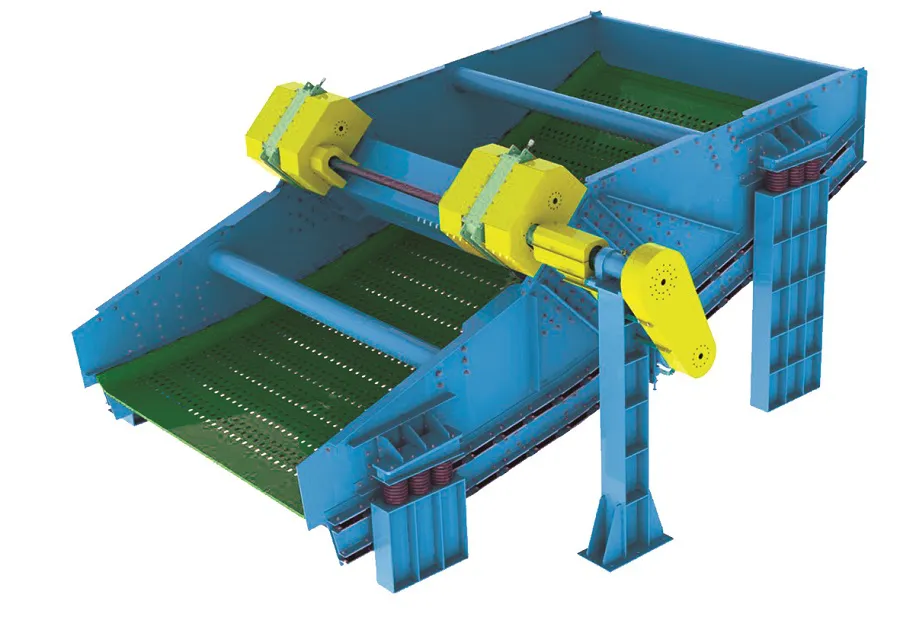
A vibrating screen is a mechanical screening machine used to separate materials, mainly in the form of particles or bulk solids, into different sizes or fractions by utilizing vibrating screens' motion. These screens typically consist of a screen deck, a frame, a vibration motor or mechanism, and screening media (such as wire mesh, polyurethane, or rubber). The vibration of the screen deck causes the particles to move along and stratify according to size. Smaller particles tend to settle to the bottom, while larger particles are retained on the screen surface. This separation process is essential in various industries such as mining, construction, agriculture, pharmaceuticals, and recycling, where the separation of materials based on size is required for further processing or utilization. The basic components of a vibrating screen include: Screen deck: This is the surface upon which the material is placed for screening. It can be made of wire mesh, perforated metal, or other materials with apertures of different sizes to allow the passage of particles of varying sizes. Vibrating motor: This is the source of vibration that drives the movement of the screen deck. Typically, there are one or more motors mounted on the sides or underneath the screen deck. The vibration generated by these motors causes the material on the screen deck to move and separate. Screen motion: Vibrating screens can have different types of motion, including linear motion, circular motion, or elliptical motion. The type of motion affects the efficiency of the screening process and the characteristics of the screened material. Support structure: The vibrating screen is usually mounted on a support structure, which may include springs or other damping elements to absorb vibrations and reduce noise.
The machine adopts horizontal feeding, so that the contact time between the material and the screen surface can be increased to the maximum extent, and the screening efficiency of the upper layer can be increased. Tumbling on the top, increasing the dehydration time of the material, and the moisture content of the material on the sieve after dehydration is < 15%.
The high exciting force makes the material quickly form a material layer on the screen surface, so that the separation effect of water and material is better.
The sieve plate of this sieve machine adopts imported polyurethane or demagnetized stainless steel slotted sieve plate, which greatly improves the efficiency of material dehydration and screening with the largest opening rate.
The design size of the exciter is very compact. This condensed design makes the exciter not only have a huge exciting force, but also can be installed on the main beam of the equipment as a whole, eliminating the trouble of replacing a single bearing. The overall disassembly and replacement only needs One hour, replacement and maintenance is very convenient.
The equipment can run stably and safely for a long time, with more than 8000 hours of trouble-free operation every year.
The equipment has vibration reduction, noise reduction and dust prevention measures, and the rotating parts of the equipment are equipped with safety protection measures for easy disassembly.



The working principle of a vibrating screen involves the separation of materials into multiple grades based on their particle size. This is accomplished through the use of an exciter or vibrator, which causes the screen mesh to vibrate. The vibration generates a continuous throwing motion of the materials on the screen surface, promoting the separation of particles of different sizes.
Vibrating screens are equipped with an exciter or vibrator, which can be an unbalanced flywheel or an electric motor with an eccentric weight. The exciter generates a rotating motion, causing the screen box to vibrate in a specific pattern.
The screen surface is a mesh or perforated surface that allows the passage of particles smaller than the openings and retains larger particles. The type of screen surface used depends on the application and the characteristics of the material being processed.
Material is fed onto the vibrating screen, typically at the top. The material may be evenly distributed across the width of the screen by a feeder.
As the vibrating screen vibrates, the material experiences a continuous tossing motion. The vibration, generated by the exciter, causes the particles to move in a series of small jumps or bounces.
The tossing motion promotes the stratification of the material, where particles of different sizes are separated into distinct layers on the screen surface.
Smaller particles pass through the openings in the screen mesh and fall through to the lower layers or collection point. Larger particles remain on the screen surface or are conveyed to the discharge end, where they may be collected or further processed.
Some vibrating screens allow for adjustments in parameters such as amplitude, frequency, and angle of inclination. These adjustments can be made to optimize the screening process for different materials and applications.
The vibrating screen's efficiency in separating particles is influenced by factors such as the amplitude of vibration, frequency, screen inclination, and the size and shape of the openings in the screen mesh.
CONTACT US
Our team of experts are ready to help find you solutions tailored to your specific needs.
Contact Us TodayCopyright © 2023 Xinxiang Zongyuan Machinery Equipment Co., Ltd. | All Rights Reserved.